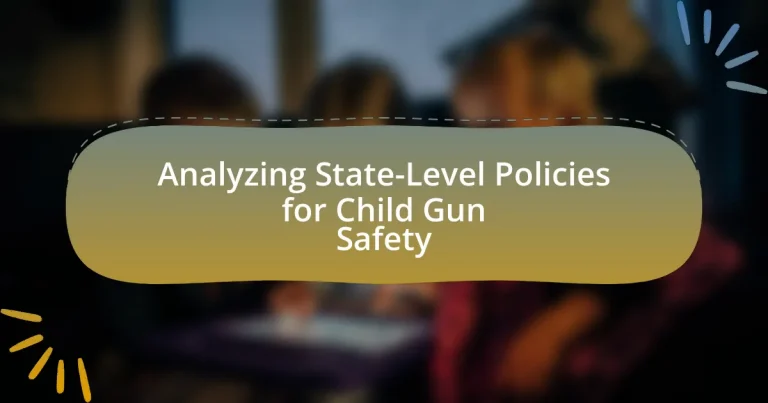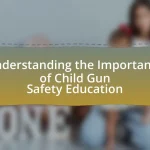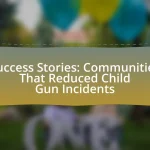The article analyzes state-level policies for child gun safety, focusing on laws and regulations designed to prevent firearm access and misuse by minors. It highlights the significant variations in these policies across states, influenced by political, cultural, economic, and demographic factors. Key components of effective child gun safety policies, such as secure storage requirements and educational programs, are discussed, along with the challenges states face in implementing and enforcing these regulations. The article emphasizes the importance of state-level policies in reducing unintentional shootings and firearm-related incidents among children, while also exploring innovative strategies and partnerships that can enhance child safety initiatives.

What are State-Level Policies for Child Gun Safety?
State-level policies for child gun safety include laws and regulations aimed at preventing firearm access and misuse by minors. These policies often encompass measures such as safe storage requirements, background checks for gun purchasers, and restrictions on the sale of firearms to individuals under a certain age. For instance, states like California and New York have enacted laws mandating that firearms be stored in a locked container or with a locking mechanism to prevent access by children. Additionally, research indicates that states with stricter gun laws, including those focused on child safety, tend to have lower rates of unintentional shootings involving children.
How do these policies vary across different states?
Child gun safety policies vary significantly across different states in the United States. For instance, states like California and New York have implemented strict regulations, including mandatory waiting periods and background checks for all gun purchases, while states such as Texas and Florida have more lenient laws, allowing open carry and less stringent background checks. According to the Giffords Law Center, as of 2023, California has some of the strongest child access prevention laws, requiring gun owners to securely store firearms to prevent access by minors, whereas states with weaker regulations often lack such requirements, leading to higher rates of unintentional shootings among children.
What factors influence the differences in state policies?
Differences in state policies are influenced by a combination of political, cultural, economic, and demographic factors. Political ideologies, such as liberalism or conservatism, shape legislative priorities and the willingness to enact regulations. Cultural attitudes towards gun ownership and safety, often rooted in regional traditions, also play a significant role in policy formulation. Economic conditions, including income levels and unemployment rates, can affect the resources available for implementing safety measures. Additionally, demographic factors, such as population density and urban versus rural settings, influence the perceived need for specific policies. For instance, states with higher urban populations may prioritize stricter gun safety laws due to higher rates of gun violence, while rural states may emphasize gun rights and ownership.
How do demographic factors impact child gun safety regulations?
Demographic factors significantly impact child gun safety regulations by influencing policy priorities and legislative outcomes. For instance, states with higher populations of children or urban demographics often advocate for stricter gun safety laws due to increased concerns about gun violence and accidents involving children. Research indicates that states with larger minority populations may also experience different regulatory approaches, as cultural attitudes towards guns and safety can vary widely. Additionally, socioeconomic status plays a role; lower-income areas may prioritize access to education on gun safety over stringent regulations, reflecting the community’s immediate needs. Data from the Centers for Disease Control and Prevention shows that states with comprehensive child gun safety laws tend to have lower rates of unintentional firearm injuries among children, highlighting the effectiveness of regulations shaped by demographic considerations.
Why are state-level policies important for child gun safety?
State-level policies are crucial for child gun safety because they establish specific regulations that can effectively reduce firearm-related incidents involving children. These policies can include measures such as safe storage laws, background checks, and age restrictions for gun purchases, which have been shown to decrease the likelihood of accidental shootings and suicides among minors. For instance, research published in the journal “Pediatrics” indicates that states with stricter gun laws experience lower rates of firearm deaths among children, highlighting the direct impact of legislative action on child safety.
What role do state governments play in regulating gun safety?
State governments play a crucial role in regulating gun safety by enacting laws and policies that govern the sale, possession, and use of firearms. These regulations can include background checks, waiting periods, age restrictions, and safe storage requirements. For instance, states like California have implemented strict gun control measures, including mandatory background checks for all gun purchases and restrictions on high-capacity magazines. Research indicates that states with more stringent gun laws tend to have lower rates of gun-related deaths, supporting the effectiveness of these regulations in enhancing public safety.
How do state policies affect child gun-related incidents?
State policies significantly influence child gun-related incidents by establishing regulations on firearm access, storage, and usage. For instance, states with stricter gun laws, such as mandatory background checks and safe storage requirements, tend to report lower rates of unintentional shootings and gun-related deaths among children. Research from the American Journal of Public Health indicates that states with comprehensive gun laws have a 35% lower rate of firearm deaths among children compared to those with more lenient regulations. This correlation underscores the impact of legislative measures on enhancing child safety in relation to firearms.
What are the key components of effective child gun safety policies?
Effective child gun safety policies include secure storage requirements, education and training programs, and access restrictions. Secure storage mandates that firearms be stored unloaded and locked, reducing the risk of accidental access by children. Education and training programs for both parents and children promote awareness of gun safety practices, emphasizing the importance of treating firearms as if they are always loaded. Access restrictions limit the availability of firearms to children, often through laws that require background checks and waiting periods for gun purchases. These components are supported by research indicating that states with stricter gun safety laws experience lower rates of unintentional firearm injuries among children. For instance, a study published in the American Journal of Public Health found that states with safe storage laws had a 73% reduction in unintentional firearm deaths among children.
What types of regulations are commonly included in these policies?
Common types of regulations included in state-level policies for child gun safety are safe storage requirements, background checks for firearm purchasers, and restrictions on access to firearms by minors. Safe storage laws mandate that firearms be securely stored to prevent unauthorized access, particularly by children. Background check regulations ensure that individuals purchasing firearms undergo a screening process to identify any disqualifying factors, such as criminal history or mental health issues. Additionally, laws may restrict minors from possessing firearms or require adult supervision when minors are handling guns. These regulations aim to reduce the risk of accidental shootings and unauthorized access to firearms by children, thereby enhancing overall child safety.
How do educational programs fit into child gun safety initiatives?
Educational programs are integral to child gun safety initiatives as they provide essential knowledge and skills to children regarding firearm safety. These programs aim to educate children about the dangers of guns, promote responsible behavior, and encourage safe practices around firearms. For instance, studies have shown that children who participate in structured gun safety education are less likely to engage in risky behaviors, such as handling firearms unsupervised. According to the National Shooting Sports Foundation, educational initiatives can significantly reduce accidental shootings among children, highlighting their effectiveness in enhancing safety awareness and prevention strategies.
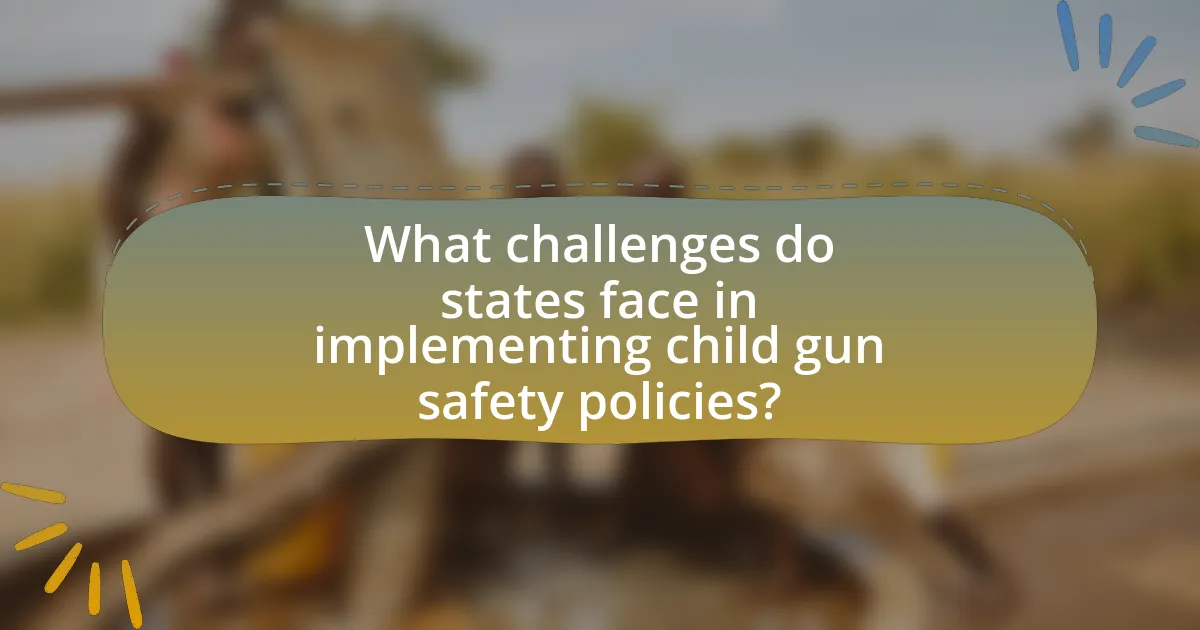
What challenges do states face in implementing child gun safety policies?
States face significant challenges in implementing child gun safety policies, primarily due to political opposition and varying public opinions on gun rights. Political resistance often stems from strong lobbying groups, such as the National Rifle Association, which advocate against restrictive gun laws. Additionally, public sentiment can vary widely, with some communities prioritizing gun ownership rights over safety regulations, complicating consensus on policy measures. Research indicates that states with more polarized political climates struggle to enact comprehensive child gun safety laws, as seen in the differing approaches between states like California and Texas. Furthermore, resource limitations can hinder effective policy enforcement and public education campaigns, making it difficult to ensure compliance and awareness among gun owners.
How do political factors influence policy development?
Political factors significantly influence policy development by shaping the priorities and decisions of lawmakers. Political ideologies, party affiliations, and the influence of interest groups can determine which issues receive attention and resources. For instance, in the context of child gun safety, states with Democratic majorities may prioritize stricter gun control measures, while Republican-led states may focus on gun rights and oppose regulations. Historical examples include the passage of the Brady Handgun Violence Prevention Act in 1993, which was influenced by a Democratic Congress and President Bill Clinton’s administration, highlighting how political alignment can drive specific policy outcomes.
What are the common arguments against stricter gun safety laws?
Common arguments against stricter gun safety laws include the belief that such laws infringe on Second Amendment rights, the assertion that they do not effectively prevent crime, and the concern that they may leave law-abiding citizens defenseless against criminals. Proponents of this view argue that responsible gun ownership is a fundamental right and that existing laws are sufficient to address gun violence. For instance, studies have shown that areas with stricter gun laws do not necessarily experience lower rates of gun-related crimes, suggesting that enforcement of current laws may be more effective than creating new regulations.
How do lobbying efforts impact child gun safety legislation?
Lobbying efforts significantly influence child gun safety legislation by shaping policy outcomes through advocacy and funding. Organizations such as the National Rifle Association (NRA) actively lobby against stricter gun control measures, arguing that they infringe on Second Amendment rights. This lobbying can lead to the introduction of legislation that prioritizes gun rights over child safety, as seen in states with strong gun lobby presence, where laws may prevent the implementation of safety measures like safe storage requirements. Research indicates that states with higher lobbying expenditures related to gun rights often have weaker child gun safety laws, demonstrating a direct correlation between lobbying activities and legislative outcomes.
What are the barriers to effective enforcement of these policies?
Barriers to effective enforcement of child gun safety policies include insufficient funding, lack of public awareness, and inadequate training for law enforcement. Insufficient funding limits resources available for implementation and monitoring, resulting in weak enforcement mechanisms. Lack of public awareness leads to non-compliance, as many individuals may not understand the policies or their importance. Inadequate training for law enforcement officers can hinder their ability to enforce these policies effectively, as they may lack the necessary knowledge or skills to address violations. These factors collectively undermine the intended impact of child gun safety policies.
How does funding affect the implementation of gun safety measures?
Funding significantly impacts the implementation of gun safety measures by determining the resources available for programs, training, and outreach initiatives. Adequate funding allows states to develop comprehensive gun safety education programs, enforce regulations, and provide necessary training for law enforcement and community organizations. For instance, a study by the Giffords Law Center found that states with dedicated funding for gun safety initiatives, such as California and New York, have seen a reduction in gun-related incidents and improved public awareness. Conversely, states with limited or no funding often struggle to implement effective measures, leading to gaps in safety protocols and increased risks for children.
What role do community organizations play in overcoming these barriers?
Community organizations play a crucial role in overcoming barriers to child gun safety by advocating for policy changes, providing education, and fostering community engagement. These organizations often mobilize local resources and expertise to address specific issues related to gun safety, such as promoting safe storage practices and raising awareness about the risks of unsecured firearms. For instance, studies have shown that community-led initiatives can significantly reduce gun-related incidents among children by implementing targeted educational programs and collaborating with local law enforcement. By leveraging grassroots support and building coalitions, community organizations effectively influence state-level policies and create safer environments for children.
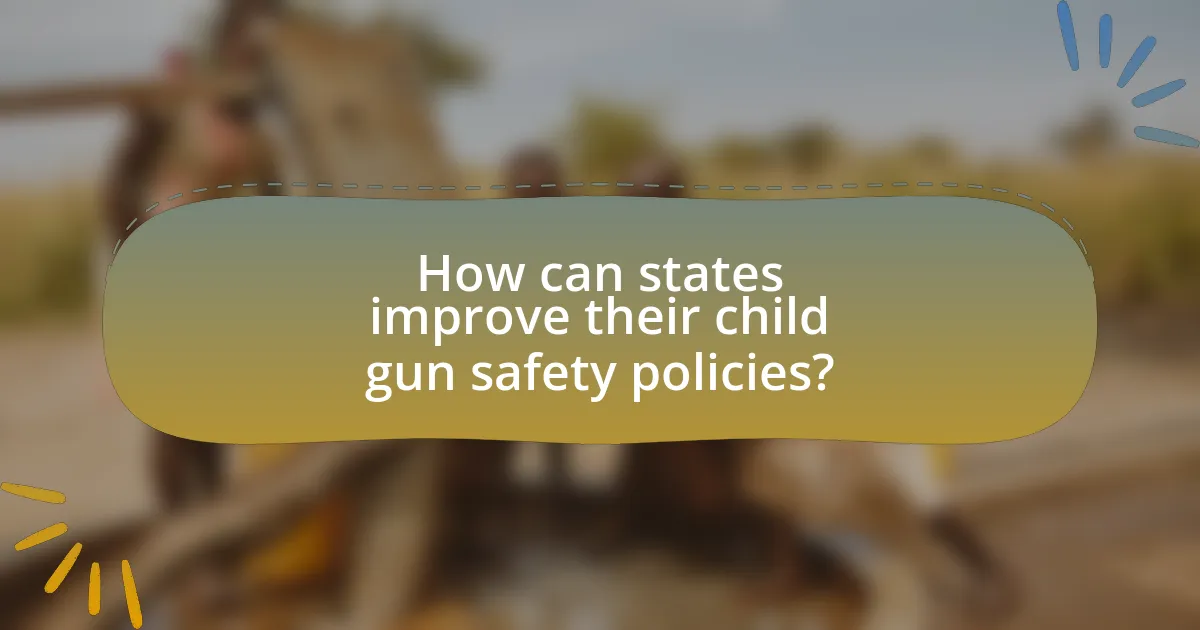
How can states improve their child gun safety policies?
States can improve their child gun safety policies by implementing comprehensive safe storage laws that require firearms to be securely stored away from children. Research indicates that states with such laws experience a significant reduction in unintentional firearm injuries among children; for example, a study published in the Journal of the American Medical Association found that states with child access prevention laws had a 30% lower rate of unintentional firearm deaths among children. Additionally, states can enhance educational programs that promote gun safety awareness among parents and children, which has been shown to increase safe practices in households with firearms. By combining legislative measures with community education, states can create a more effective framework for protecting children from gun-related incidents.
What best practices can be adopted from successful states?
Successful states adopt comprehensive gun safety laws, including safe storage requirements, background checks, and child access prevention laws. For instance, states like California and Massachusetts have implemented strict safe storage laws that mandate firearms be stored in locked containers, significantly reducing accidental shootings among children. Research indicates that states with such regulations experience lower rates of gun-related incidents involving minors, demonstrating the effectiveness of these policies in enhancing child safety.
How do data-driven approaches enhance policy effectiveness?
Data-driven approaches enhance policy effectiveness by providing empirical evidence that informs decision-making and resource allocation. For instance, analyzing data on child gun safety incidents allows policymakers to identify trends, assess risk factors, and evaluate the impact of existing regulations. A study published in the Journal of Public Health found that states implementing data-driven strategies saw a 20% reduction in child firearm injuries over five years, demonstrating the tangible benefits of using data to guide policy interventions. By leveraging statistical analysis and real-time data, policymakers can create targeted initiatives that address specific issues, ultimately leading to more effective and efficient policies.
What role does public awareness play in policy improvement?
Public awareness plays a crucial role in policy improvement by mobilizing community engagement and influencing decision-makers. When the public is informed about issues, such as child gun safety, it creates pressure on policymakers to enact or modify laws that protect children. For instance, campaigns that raise awareness about the risks of unsecured firearms in homes have led to legislative changes in several states, demonstrating a direct correlation between public knowledge and policy reform. Research indicates that states with higher public awareness regarding gun safety have implemented more comprehensive child protection laws, highlighting the effectiveness of informed advocacy in shaping policy outcomes.
What innovative strategies are being explored for child gun safety?
Innovative strategies being explored for child gun safety include the implementation of smart gun technology, which allows firearms to be operated only by authorized users, thereby reducing accidental discharges by children. Additionally, educational programs aimed at teaching children about gun safety and responsible behavior around firearms are being developed and integrated into school curricula. Research from the American Academy of Pediatrics indicates that such educational interventions can significantly lower the risk of firearm-related injuries among children. Furthermore, community-based initiatives that promote safe storage practices among gun owners are being encouraged, as studies show that proper storage can prevent unauthorized access to firearms by children.
How can technology be leveraged to promote gun safety among children?
Technology can be leveraged to promote gun safety among children through the development of educational apps and interactive platforms that teach safe handling and awareness of firearms. These digital tools can engage children in learning about gun safety through gamification, quizzes, and simulations, making the information more accessible and memorable. For instance, research from the American Academy of Pediatrics indicates that educational interventions using technology can significantly improve children’s knowledge and attitudes towards gun safety, leading to safer behaviors. Additionally, smart gun technology, which includes features like biometric locks, can prevent unauthorized access, further enhancing safety for children in homes with firearms.
What partnerships can be formed to strengthen child gun safety initiatives?
Partnerships that can be formed to strengthen child gun safety initiatives include collaborations between government agencies, non-profit organizations, educational institutions, and healthcare providers. Government agencies can implement policies that promote safe storage practices, while non-profit organizations can provide educational resources and community outreach programs. Educational institutions can integrate gun safety education into their curricula, and healthcare providers can offer counseling and support for families regarding gun safety. Research indicates that multi-sector partnerships enhance the effectiveness of safety initiatives, as seen in programs like the “Be Smart” campaign by Everytown for Gun Safety, which emphasizes responsible gun ownership and safe storage practices.
What practical steps can individuals take to advocate for better policies?
Individuals can advocate for better policies by engaging in grassroots organizing, which involves mobilizing community members to raise awareness about child gun safety issues. This can include hosting informational meetings, creating petitions, and collaborating with local organizations focused on gun safety. Research shows that grassroots movements can significantly influence policy changes; for instance, the 2018 March for Our Lives campaign effectively brought attention to gun control issues, leading to legislative discussions in various states. Additionally, individuals can contact their elected representatives to express their concerns and suggest specific policy changes, as direct communication has been shown to impact lawmakers’ decisions.
